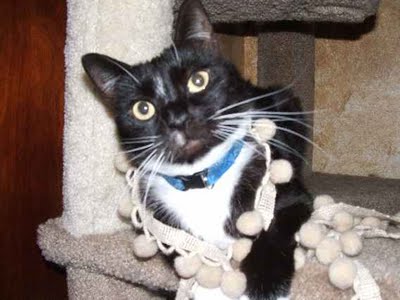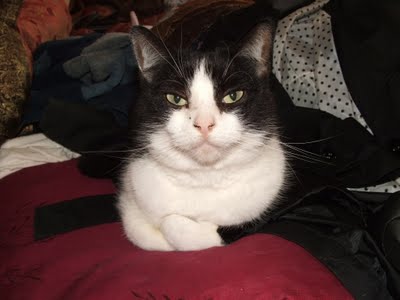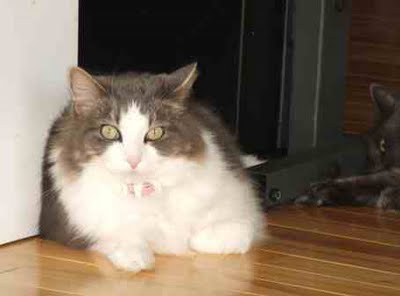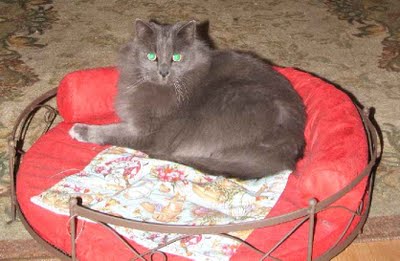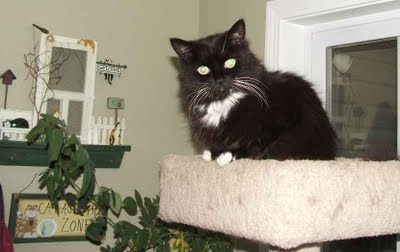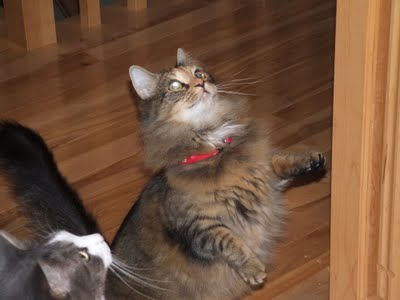This is not an easy post to write, but I needed to get out the experience I had with FIP in order to be referenced during Muffin's and Eli's upcoming posts.
In the fall of 2002 I brought home a set of orphaned kittens. There were six of them and they were a LOT of work. This being my first fall using the downstairs room to foster, I didn't realize how cold it would get down there. Not ideal for young orphaned kittens who have a hard time regulating their own body temperature.
At the time I had a mother kitty with four kittens. I didn't know this at the time, but not all of the kittens were hers originally. I still don't know who was an add on and who she gave birth to. Not that it matters. I talked to the shelter about the orphans, and they suggested that I take my mother cat and see if she would nurse the orphans - since her four kittens were eating on their own and were doing just fine.
Well she did take to them ok, but it didn't seem very fair to leave her with out contact with her own kittens. It was still very cold in the basement, and I figured if they thought it was ok to put the mother with the kittens, why wouldn't it be ok to put the kittens with the mother instead, so I combined the two groups into the warmer of the two rooms.
Orphaned kittens can not be tested for Felv/FIV until they are six weeks of age. It apparently wasn't even considered that this could be a problem, but sadly it was. The orphan's story is quite heartbreaking on it's own but that is the past. They taught me a lot of respect for fostering, and being aware of what COULD happen. If nothing else, their short lives were for something. The shelter's policy on kittens is to euthanize if they are found to be felv or fiv positive. I understand a lot of people find that offensive, but I have to respect the shelter for realizing their limits and accepting their financial resources should be limited. Yes, they could have kept these kittens for another few weeks and tested again, but then those funds could go into an animal that absolutely can be saved, and not drained in the risk of maybe they would fight off the infection. I don't like it, in fact I hate it. But I hate the fact that any animal needs to be put down before it's time, and better it be for an incurable illness then a fixable injury
***just an aside. Felv/FIV should not be a death sentence for a loved pet. A lot of cats can live long healthy happy lives infected with these horrible diseases. Both work on the immune system, so cats who are infected need to be cared for a little more cautiously, but it does not mean they are going to immediately die. Kittens brought into a shelter with Felv or FIV could be raised and very well could be neutered/vaccinated and not have health issues, but it is a risk that the disease could cause problems, and frankly it is VERY hard to find people to adopt these types of cats. Why would they take a chance on a cat with a known health issue, when right next door is a kitty who is healthy and just as cute? It sucks, but it is life in a shelter system.
So now we have a known exposure to Felv for the four kittens and the mom who remained. I was asked to keep them for six weeks and have them tested again. What a hardship on me, because the longer you have a kitten, the more your heart attaches to them. But I was already head over heels for one of them, and didn't mind having him around. The whole family was constantly battling URIs, and except for a really bad case over Thanksgiving, they did seem to abate while waiting out the incubation period.
Six weeks later, we had them tested. Unbeknownst to me, the shelter only tested the mother and one of the kittens. I do not know who, but it really doesn't matter. The test came back negative, and I was never so thrilled to hear of a failed test :) Took me quite a few minutes before I could wrap my brain around negative being good. I brought them all home with me, and we had decisions to make. The litter of kittens had two boys and two girls. Both of the girls were totally full of it - personality up the wazoo. One of these "Muffin" was also quite photogenic. She loved being photographed, and being in the middle of things all the time. The boys were "Eli" and "Kodi". Kodi was a beautiful cat, and both my husband and I wanted to keep him very much. We felt we were at our limit of cats with three, and I tried to convince my husband that we didn't want to keep him with "Well if we keep Kodi, we have to keep Muffin and Eli too!" (The other girl kitten "Izzy" just did not bond with us at all, and I am sure she has found her perfect place in life just as she was meant to) Some how he agreed and we went from a three cat household to a six cat household. It was crazy and insane, but some how it worked.
Unfortunately Kodi never did get over his URI. He battled congestion continually. I finally brought him to my own vet (outside of the shelter system) who recommended a less aggressive course of treatment for it. URI in owned cats is generally viral, so most medications you can give won't really help. It is mostly supportive care and making sure they can eat that is critical. I place absolutely no blame on my former vets for what happened next, because I doubt that even taking an aggressive stance with the URI would have changed anything.
Kodi got worse, and my vet couldn't see him for a couple of days, so I decided to bring him to the vet that saw him previously. They gave him a much more aggressive treatment for his URI, but it didn't make much of a difference. On a follow up exam, it was determined he had a fever. URI and fever generally don't go together, so we started looking for different reasons for it. Well in the end they settled on FIP. I almost fell down - having just read about FIP the week before.
FIP is a mutation of a very common virus that generally is found in cats. In fact pretty much every shelter cat has been exposed to it, and except for maybe a few private catteries who aggressively eliminate it, well lets just say it is very common. The mutation is not. They still don't know why the virus mutates. While their understanding of FIP has come a long way (when I first started reading about it on the web, most of the information was from the 80s and 90s. and that it was that it was highly contagious) there still is much that is unknown - and pretty much unknowable at this point. There is no test for FIP. Previously they tested for the coronavirus - which is the virus that mutates - and which is the tests that were run on my cats. I did not know, and the extremely high titers that came back scared the living daylights out of me. It was recommended we test again in six weeks, and several of the cats tested even higher. I was told by the vet attending my case that this means the cats are shedding the virus and this was bad news. She could not tell me much more then that. She also went behind my back and told the shelter I should no longer foster kittens because it was dangerous for them. She not once told me she felt this way - which I found to be a huge betrayal (especially since I was now working for the veterinary clinic she was working at)
Well I never stopped reading about FIP and over time I realized how wrong this vet was. FIP is a diagnosis of last resort since there is no test. There are two forms. Wet FIP which fills the cat up with fluid is pretty obvious but still is not conclusive to be FIP. Dry FIP is much more elusive, because other then general malaise and a fever, there is no definitive clues that says "YES! this is FIP" I can't strongly recommend highly enough (enough adjectives there?) that anyone facing an FIP diagnosis get their kitty to a new vet for a second if not third opinion. Since you are reading this on the web, I also recommend you find an FIP active online community forum who can help you look for other conditions that have been previously diagnosed as FIP that hopefully your cat has instead of FIP and can be treated. (yahoo groups has several at the time I'm creating this post, but I'm sure there will always be others)
But unfortunately what she was not wrong about was that he had FIP. Poor Kodi had a tragically short life. While I did not end up doing a necropsy to be absolutely certain he had FIP, he ended up bleeding into his eyes, and had several other classic FIP issues. Could it have been something else? I guess. And I so wish I had thought to bring him to a different vet back after I first got the diagnosis for him. Probably wouldn't have changed anything, since I was ignorant of what FIP was, and I was unable to get my hands on any of the new information until quite a long time after Kodi passed.
My whole point with this blog is to share information. This is what I faced, and this is what I chose to do and faced with this again, the changes I would make. I don't always succeed in not being obnoxious about things (declawing, food, free roaming outdoor kitties) but it is never my intention to make anyone feel they were wrong about decisions they have already made. What is done is done, and all you can do is make decisions from the point you are and go on. If you had a kitty die of FIP, I am very sorry. My heart breaks for you because I have been there and done that. If you are here because you just got the FIP diagnosis, please learn from my ignorance, and get a second or third or fourth opinion for your kitty. Google the living daylights out of FIP, and learn all you can about all the new research, and all of the different illnesses that can mimic FIP for a doctor who is not quite as up to date on things.
The more out of touch your vet is, the faster they are going to come up with an FIP diagnosis.
Labels: FIP, Kodi
